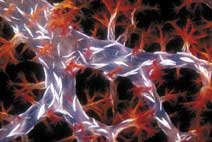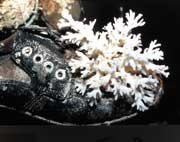Coral: Animal, Vegetable and Mineral
Originally published in Creation 25, no 1 (December 2002): 28-32.
The world’s coral reefs provide some of the most spectacular natural colour on the planet.
Despite an appearance of simplicity, the tiny individuals that make up those reefs are some of the most complex in the living world.
While often referred to as the “rainforest of the ocean”, corals are actually animals, not plants. But much of their colour comes from the algae (not plants either, strictly speaking) that live in a remarkable symbiotic (‘living together”) relationship with them.

Gary Bell © www.oceanwideimages.com
Corals belong to the phylum Coelenterata (from the Greek meaning “hollow gut”), which also includes jellyfish, for example. The corals of the Madreporaria order make up the bulk of the coral world, such as those in Australia’s Great Barrier Reef and the Maldives Archipelago in the Indian Ocean.1
Coral species live mainly in the well-oxygenated, warm, sunlit waters of the tropics; however, some varieties can also survive in the cold, dark waters of the abyss, under the enormous pressure at depths of several kilometres.
An individual coral is known as a polyp, a soft organism comprising a base, a hollow gastro-vascular (“stomach-vessel”) tube, and a mouth opening surrounded by tiny tentacles.
Each polyp is hermaphrodite (i.e. having both male and female sexual organs). There are two types of sexual reproduction in coral. In “brooder” corals, the egg is fertilized within the polyp, incubated and then later released into the ocean. In externally fertilizing corals, some polyps release sperm, others eggs. In the awesome phenomenon known as mass coral spawning, all the corals in one geographic region release their eggs/sperm on the same night, all synchronized by the phases of the moon.
The resultant larva (or planula) must survive drifting in the open sea as part of the surface zooplankton (microscopic floating animals). If it does not drift too far out to sea, or is not devoured by plankton-eating predators, it settles to the seabed after a few days, attaching itself to a suitable solid support.
The new polyp is already incredibly specialized, with three layers of complex cells. The outer layer comprises stinging cells that provide an excellent defence against predators and help it hunt for food (see The poisonous “harpoon”); the inner layer provides the necessary tools for digestion; and the middle layer provides the connective tissue.
Enemies

Gary Bell © www.oceanwideimages.com
Corals have a number of enemies, including a range of fish species protected against the polyp’s stony skeleton, and immune to its secreted poisons.
However, the greatest enemy to coral is the Crown of Thorns Starfish. It sits on a coral outcrop, opens its stomach to surround a coral structure, and literally eats it alive by dissolving the organic material with its digestive enzymes.
The coral polyp now begins to build walls like a castle, complete with cross walls and buttresses, producing building blocks by secreting calcium carbonate. Incredibly, as the walls around it grow taller, the polyp vacates the lower chamber and moves to the upper storey of its self-built tower, leaving behind the skeleton.
These towers are the hard mineral skeletons that characterize coral reefs, and in which the polyps live. They generally stay retracted within the skeleton in the day, expanding at night and waving their tentacles around to catch microscopic animals.
Some polyps live alone, while others form a colony. The creation of a colony requires a second type of reproduction, called asexual “budding”. A new bud secretes its own skeleton alongside the parent polyp. As new polyps develop, the old ones beneath die, but the skeletons remain.2
Anyone who has ever kept a marine tank knows how tricky it is to keep coral alive, let alone thriving. It requires a delicate balance of water clarity, salinity and the right temperature, while the slightest change can be the death of your coral colony.
In its natural habitat, coral is able to react to its environment to protect itself from its three major environmental threats: hot sunshine, powerful waves and coatings of sand (which, if thick enough, can asphyxiate it). To shield itself from the hot sun that can penetrate the water during low tide in summer, a coral secretes mucus; to steady itself against pounding waves in the storm season, it builds strong foundations; and to rid itself of sand coatings, the coral cleans itself with its tentacles.
Amazing combination of animals and algae
The poisonous “harpoon”

Gary Bell © www.oceanwideimages.com
As mentioned in the main article, a coral polyp has stinging cells (nematocysts) that it uses to kill small prey (generally plankton) and defend itself from predators.
Each stinging cell has a trigger, a “harpoon” attached by a hollow line and a spring, which is triggered by passing plankton. In a few thousandths of a second, the capsule lid of the stinging cell flies open and the liquid inside is suddenly relieved of pressure, forcing out the stinging filament. The filament is inverted, like a rubber glove turned inside out, and rolls itself out. Barbs on the inside swing round to the outside and tear a hole in the victim, and the filament enters the hole to inject a charge of venom.
The ability to hunt plankton in this manner requires perfect coordination between muscle cells, sensory cells and the nerve cells of the polyp.
The harpoon is remarkable evidence of complex design, but it also reminds us that we live in a fallen world.1
Footnote
- For more details on the origin of such structures, see Batten, D. (Ed.), The Answers Book, Answers in Genesis, Queensland, Australia, chapter 6, How did “bad things” come about?, 1999. Return to text.
One of the most fascinating aspects of the coral’s life cycle is the partnership it has with algae to provide the sugar the coral needs to survive.
Algae (known as zooxanthellae) living within the polyp’s tissues carry out photosynthesis, which in turn creates the sugar used to give the polyp energy. This symbiotic relationship is the reason corals require brightly lit water—for the health and success of their algal partners.
In fact, the zooxanthellae are so vital they are often considered an organ of the polyp, without which the coral would grow more slowly and produce fragile skeletons. In a coral colony, there is usually about three times as much algal tissue as there is animal tissue.
Zooxanthellae not only provide coral polyps with vital sugars, they also contribute to the colours of corals. The algae’s chlorophyll mixes with the yellow, blue, orange, violet and brown pigments dispersed in the polyp. These tissue pigments, in turn, are fluorescent, converting ultraviolet light into the many colours of visible light seen in so many corals.
There are other types of coral that do not have zooxanthellae. These don’t need the sunlight of the tropical varieties, and tend to live in deeper, darker waters. For example, black corals are hard, black and thorny, and look like fine tree twigs. They live at anything from 30 m (100 ft) to 2.5 km (1.5 miles) below the surface.
The location of dead coral beds tells an interesting story about the Earth’s geological activities. Dead coral (of the type usually found in shallow tropical waters) has been found at great depths, indicating the seabed has at some time sunk. Likewise, dead coral found well above sea level indicates a raising of the Earth’s crust. Of course, such geological movement is consistent with the Biblical account of a worldwide Flood (and its aftermath), which would have involved enormous shifts in the Earth’s foundation.
Given the complex nature of the coral’s life cycle—from the precise habitat requirements to its critical symbiotic relationship with the zooxanthellae—it seems incomprehensible that this marine creature evolved by chance mutations, filtered by selection.
The beautiful colours of coral, produced as a wonderful byproduct of the symbiotic relationship between polyp and algae, seem to be—as three secular authors describe them—“apparently for our pleasure”.3
Scientists describe coral as “among the most ancient life forms that still thrive on earth”,4 a term ascribed to so many marine creatures (e.g. sharks and turtles, to name a few). Some naturalists claim that the earliest corals evolved 500 million years ago, became extinct 200 million years ago, and were replaced by “similar” corals that became the ancestors of today’s corals.5 What they are interpreting as an evolutionary sequence over millions of years is actually the order in which the fossils were deposited during the year-long global Flood.
But there is no evidence that coral descended from anything other than coral. And (see Telling a geological tale) there is no reason to believe that it took millions of years for the coral reefs we see in the world today to have formed.
Telling a geological tale

Until actually observed, the growth rates of coral were once thought to be much slower than research has now shown.
A coral reef is the mass of limestone created as the polyps build their skeletons. How long it takes these reefs to form is a matter of conjecture.
It is commonly believed the existence of thick coral reefs proves the Earth must be millions of years old, based on the assumption that coral growth was slow.
However, the discovery in 1992 of this substantial wad of coral growing firmly attached to a modern shoe (less than four years old at the time) in waters off the Philippines is just one indicator among many that this is not the case.1
Marine biologists have discovered that coral contains growth rings, like those of a tree. A study by the Australian Institute of Marine Science has found a connection between coral growth rates and seasonal freshwater run-off or floods from nearby land.2
From strongly correlated historical records of river run-off and flooding, the researchers determined that the coral colony in question had taken only 118 years to grow 1.8 m (6 ft). This gave them a new method for determining the age of all reefs that make up Australia’s Great Barrier Reef. Based on this methodology, the outer barrier reefs (those furthest from the Australian coast and in the deepest water), which are about 55 m (180 ft) thick, would be less than 3,700 years old—not millions of years old as has been believed.
Footnotes
- Coral on a shoe, Creation 16(3):15, 1994. Return to text.
- Read, P. and Snelling, A., How old is Australia’s Great Barrier Reef? Creation 8(1):6, 1985. Return to text.
Footnotes
- Unless otherwise stated, all information in this article is sourced from: Robin, B., Petron, C. and Rives, C., Living corals, Times Editions, France, 1997.
- The New Encyclopaedia Britannica, 15th edition, 3:618, 1992.
- Robin, B., Petron, C. and Rives, C., Living corals, p. 34.
- Wallace, J., Coral Reefs: Exploring the World Below, Friedman/Fairfax, p. 12, 1995.
- Wallace, J., Coral Reefs: Exploring the World Below, Friedman/Fairfax, p. 12, 1995.
Recommended Resources

Answers in Genesis is an apologetics ministry, dedicated to helping Christians defend their faith and proclaim the good news of Jesus Christ.
- Customer Service 800.778.3390
- Available Monday–Friday | 9 AM–5 PM ET
- © 2025 Answers in Genesis



